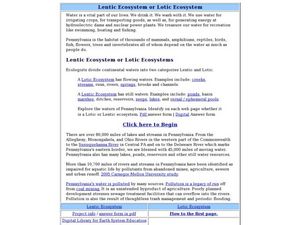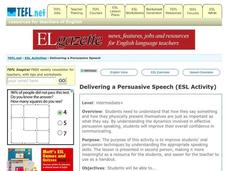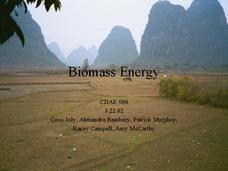Curated OER
How is Atomic Energy Used Today
Students investigate energy sources by examining photographs. In this atomic energy lesson, students identify and describe various pictures and how atomic energy is used in them. Students create a presentation demonstrating how many...
Curated OER
Dangerous Air
Students investigate how pollution is a global issue. They locate the countries affected by radiation from Chernobyl, sequence the progress of radiation transport from Chernobyl and plot the pollution points on a world map, and read and...
Curated OER
Satire in Fiction
Twelfth graders identify satire in various fictional texts. For this language arts lesson, 12th graders will learn to define satire, parody, and caricature. Students will identify different forms of satire in historical and modern-day...
Curated OER
Applied Science - Built Environment (2) Pre Lab
Second graders review how our society affects nature. In this energy lesson, 2nd graders discuss the different ways that energy is collected. They review renewable and nonrenewable energy sources.
Curated OER
Surrounded by Radiation
Students explore ways in which people are constantly exposed to naturally occurring and man-made sources of radiation. They create and play a board game featuring different hypothetical scenarios of radiation exposure.
Curated OER
Lentic Ecosystem or Lotic Ecosystem
Students explore the differences between lentic and lotic ecosystems. For this ecology lesson students study the water systems in Pennsylvania.
Curated OER
Delivering a Persuasive Speech
To prepare to deliver a persuasive speech, class members examine not only how to craft a speech, but consider body language, articulation, pronunciation, pitch, pace, and volume as well.
Curated OER
Applied Science - Built Environment Post Lab (Energy)
Learners study science. In this efficiency lesson, students explore different forms of energy and compare them to determine which works the best. They work independently to create a collage of different energy sources (using magazine...
Curated OER
SURVIVING A COSMIC INVASION
Young scholars read periodicals relating to radioacitivity and interpret a Geiger Counter. They work in small groups, share information and help each other explain the Geiger Counter. They discover the relationship distance to...
Curated OER
What Is A Dirty Bomb?
Young scholars read an article about dirty bombs and then use a worksheet as a discussion guide to consider surrounding issues. They use balloons, cornstarch and iron fillings to demonstrate the possible impact of a dirty bomb.
Curated OER
Science Crossword Puzzle - Energy Sources
In this science crossword puzzle, students determine the answers to 8 clues with vocabulary words that name energy sources. They fill in the puzzle across and down.
Curated OER
Delivering a Persuasive Speech
High schoolers demonstrate the appropriate classroom public speaking and listening skills that would be necessary to influence or change someone's mind or way of thinking about a topic. They define the elements of persuasion and...
Curated OER
Advanced Sentence Completion Exercise 9
For this online interactive grammar skills worksheet, students examine 10 sentences that are missing words and select the appropriate words to complete each of the sentences and match them to the sentences. Student answers are...
Curated OER
What is the Rock Cycle?
Students investigate the rock cycle. In this geology lesson, students read about the rock cycle on a website and discuss the steps of the rock cycle. Students visit a rock cycle website to complete a quiz. This is the first introductory...
Curated OER
I Won't Live in a Toxic World
Students examine four separate environmental health issues using fish-bowl technique, and discuss roles of both government and citizens in maintaining a pollution-free environment.
Curated OER
Standard 4 Review-Human Impact
In this human impact on the environment worksheet, students fill in the blanks to complete sentences about how humans have negatively affected the environment. They complete sentences about the actions taken to reduce and repair the...
Curated OER
Book Excerpt from "The 23rd Cycle"
In this solar storms instructional activity, students read an excerpt from the book "The 23rd Cycle: Learning to Live with a Stormy Star". Students answer 7 questions about the effects of solar storms on radiation exposure, health risk...
Curated OER
Biomass Energy
Consider biomass as an alternative energy source with this PowerPoint. Environmental science pupils discover the potential of converting gases produced by landfills into useful energy. They compare and contrast environmental and economic...
Curated OER
Introduction to Risk Analysis
Students examine the use of risk analysis in minimizing the likelihood of unwanted side effects of a new technology. Students discuss risk analysis, practice calculating risk, and explore how decisions are made based on the calculation...
Curated OER
Matter and Chemical Bonding
For this chemical bonding worksheet, students read about the invisible killer, dihydrogen monoxide. Students read about the products it is used in and the problems it causes to the environment. Then students complete 19 short answer...
Curated OER
Applications of Hyperbolas
In this hyperbola activity, 10th graders solve and complete 6 different problems. First, they determine the cross-section of a hyperbolic paraboloid curve. Then, students find where the cone intersects the ground in hyperbola as...
Curated OER
Energy: Exploring Alternative Forms
In the study of science, there is always
going to be research, data, theories and wonderful new discoveries. I feel that my interest
about energy will help me design an adequate unit full of intrigue and discovery. The
students should...
Curated OER
Primary Energy Sources Pros and Cons
Students explore the different types of renewable and nonrenewable energy sources. In this earth science lesson, students discuss the pros and cons of each type. They conduct a variety of experiments on renewable energy.
Curated OER
Conservation of Energy
In this energy learning exercise, students read about the Law of Conservation of Energy and compare the 6 forms of energy. Then students complete 20 matching, 2 short answer, and 6 word problems.

























